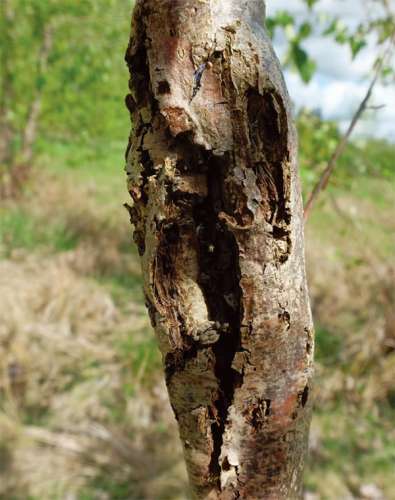A scientific investigation into the genetics of 20 fungi that infect trees has turned up an unusual explanation for why one particular fungus is killing plantation-grown poplars. According to Richard Hamelin, a forestry professor at the University of British Columbia, the fungus Mycosphaerella populorum has co-evolved with wild poplars, and the wild trees and fungus have come to a sort of truce. The fungus causes round black spots on the leaves in mid-summer, and the leaves fall off a little earlier in the fall than usual, but the trees in natural settings are otherwise unaffected. But in the hybrid poplars typically grown in plantations, the fungus infects the stems and woody tissue, which often leads to the tree’s death. Hamelin said that’s because the fungus that infects the stems has “extra genes.”
When Hamelin sequenced the genome of the fungus attacking the stems of plantation trees, he found genes that are not in the variety that only affects the leaves. And when he analyzed those extra genes, he discovered that they were not inherited from close relatives but from a completely unrelated species.
“The way human genes are inherited, your progeny get half their genes from each parent, and it works the same way with fungi,” Hamelin explained. “But the surprising thing we found with this pathogen is that the extra genes in the stem-infecting form were inherited through a horizontal gene transfer in a way we don’t yet understand.”
He speculates that as leaves fall to the ground, microbes and other organisms that live nearby could cause a gene transfer. “It’s probably rare, but it appears to be more common than we ever thought,” he said.
Hamelin said that as scientists sequence the genomes of more and more species, they are finding it to be common that some organisms tested have more genes than others of the same species. And those extra genes are frequently acquired by horizontal gene transfer from an unrelated species.
What those extra genes do is usually unknown, but Hamelin believes that the extra genes in the poplar fungus produce a toxin that affects the tree tissue. “The genes we found code for secondary metabolites, which are typically toxin producers,” he said. “We haven’t yet identified what the toxin does, but that will be our next step.”
The discovery of the extra genes in the poplar fungus was somewhat surprising. Hamelin and his research team set out to compare the genomes of various fungi that infect trees to determine what genetic factor turns a fungus into a tree-killer. “The ability of a fungus to infect and kill plant tissue is unusual,” he said. “Most fungi are beneficial; the ability to kill living plants is an exception. We’re trying to understand the genetic makeup that kills trees.”
Mycosphaerella populorum lives exclusively on poplars, but its close relatives use wheat and bananas as host plants, while other relatives cause pine blight and sudden oak death. “We’re still on the lookout for what is causing the other fungi to become tree killers,” he said, “and we’re finding some pretty exciting stuff.”


